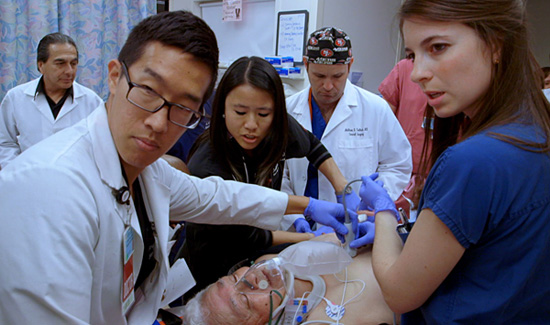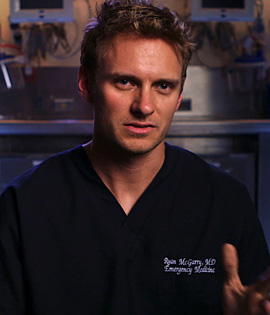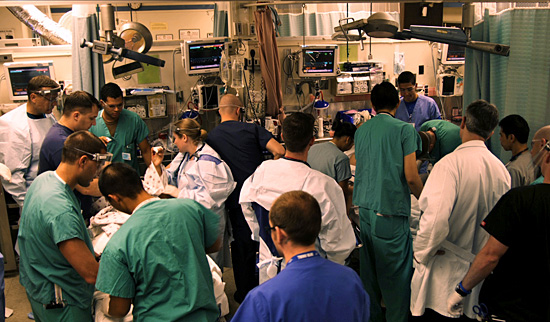Cracking the ER “Code”
August 13, 2014
In the beginning, the idea was simply to produce some archival footage—a project pitched by a young medical student to document life-saving efforts unfolding amid the controlled chaos of the emergency room at Los Angeles County’s old General Hospital.
It was there, on the edge of downtown, that the concept of emergency medicine was born in 1971 and, in some respects, had remained the same in theory and practice throughout the ensuing decades.
Despite medical modernizations that had become the norm at most hospitals, the emergency crew at the renamed Los Angeles County-USC Medical Center still operated more like a battlefield MASH unit. Crowds of doctors and nurses swirled around patients suffering the most catastrophic of injuries. Side by bloody side, the stricken were packed into a cramped trauma bay in the ER called “C-booth,” with barely a curtain between them.
But in 2008, all that was about to change, and first-year resident Ryan McGarry, who also had a keen interest in filmmaking, wanted to capture the era before it was gone. Because of earthquake damage to the old county hospital, the emergency department was moving next door to a new state-of-the-art facility that would rocket the doctors into 21st century medicine, complete with its emphasis on patient privacy and layers of paperwork.
Although initially modest in scope, McGarry’s ambitions for the project soared with the support of top Los Angeles County officials and the help of a producing team that included USC Distinguished Professor Mark Jonathan Harris, who has won three Academy Awards for documentaries.
McGarry’s film, Code Black, opened nationwide in June and has become a critical success, a gripping and graphic look at the shifting world of emergency medicine for the destitute and working poor who rely on public hospitals, such as County-USC, for their care. The term Code Black refers to the hospital’s designation for the highest level of emergency room crowding. Among other honors, the film won the Jury Award for best documentary at the 2013 Los Angeles Film Festival.
Focusing on a cadre of idealistic young residents, including himself, McGarry explores the challenging new realities for the next generation of emergency room physicians as they remain committed to maintaining a personal connection with patients while confronting the escalating regulatory demands and settings that emphasize patient privacy.
Dr. Sean Henderson, chairman of the hospital’s emergency department, says his 21-year-old daughter saw the documentary at a film festival in Santa Barbara and was so inspired that she changed her major.
“She decided to become a physician’s assistant because of that movie,” he said.
“Often, doctors are portrayed as overpaid snobs who don’t really care,” he continued the other day, sipping a caffeine-free Coke in his office in the old county hospital. “But I think you’ll see in this movie that this is not always the case. There are people doing things because they really care about the people they serve.”
Still, Henderson said he has some personal reservations about the film—a project he inherited from his predecessor, Edward Newton—and isn’t sure he would have green-lighted it himself.
“I’ve never believed in cameras in the hospital,” he explained. “The fact that you’re in an emergency room with an unplanned, unscheduled, unanticipated event—stressed, waiting, probably less informed than you’d like to be—I think that’s a very vulnerable place to be.”
That said, Henderson praised the filmmaker for getting two sets of consents from patients whose emergency room visits are shown in the film—everyone from a drunken man belting out a romantic ballad in the waiting room to the family of a patient whom doctors unsuccessfully fought to save as they cut into his chest to keep his heart beating.
Henderson, who became department chair in 2012, also appears in the film, but mostly to defend a prominently featured action he imposed in the face of a severe nursing shortage. In a dramatic segment of the documentary, he shut down an area of the new emergency department, creating a monumental patient backlog, to make the point “that we couldn’t continue to care for all these people with inadequate resources.”
“I caused the crisis and I had to defend the crisis. I was the villain,” he said, and then offered a fuller explanation of his actions than he did in the film.
He said that in the past, before Health Services Director Mitchell Katz’s arrival in 2011, “the way you got attention in the county system was to create a crisis. It wasn’t just me. It was throughout the system…If you have a crisis, resources are pulled from someone who’s not having a crisis to take care of your crisis. And so, without permission from the school [USC] or the county, I created a crisis knowing full well that it would create a pushback downtown that would allow them to hear my pleas that heretofore had gone ignored.
“It was manipulative, it was sneaky, and mea maxima culpa. But it worked,” he said, noting that more funding was soon made available for the desperately needed nurses.
Another top L.A. County emergency department official, Dr. Erin Wilkes, said she’s seen her good friend McGarry’s film more than a dozen times in various stages along the way. The two were residents together, beginning in the old hospital’s emergency department. Today, she’s the director of Emergency Medicine Systems Innovation & Quality.
Wilkes said she helped organize various Code Black screenings for county officials, including the Health Services executive team. The feedback was mostly positive, she said, although “there were a lot of questions about what the consent process was like.” Wilkes said McGarry obtained his first consents at the hospital and then got a second round of permissions after showing people the actual footage he wanted to use.
Wilkes said she’d now like to build on Code Black’s positive buzz by holding a panel discussion event at USC that would include McGarry, now an assistant professor of emergency medicine at New York-Presbyterian/Weill Cornell Medical College.
In a recent interview with the emergency medicine publication ACEPNow, McGarry talked about the demands of simultaneously pursuing his residency and filmmaking. “It was three years of no vacation,” he said. But he said he had no regrets.
“One thing that I feel very lucky to have experienced,” he said, “is nonmedical people sitting through some pretty tough stuff in cases we show. And at the end of the film people give us a standing ovation. I wish I could share that with every physician, nurse and X-ray tech who leaves a really tough shift.”
Posted 7/17/14















 405 bridge work causes a stink
405 bridge work causes a stink
